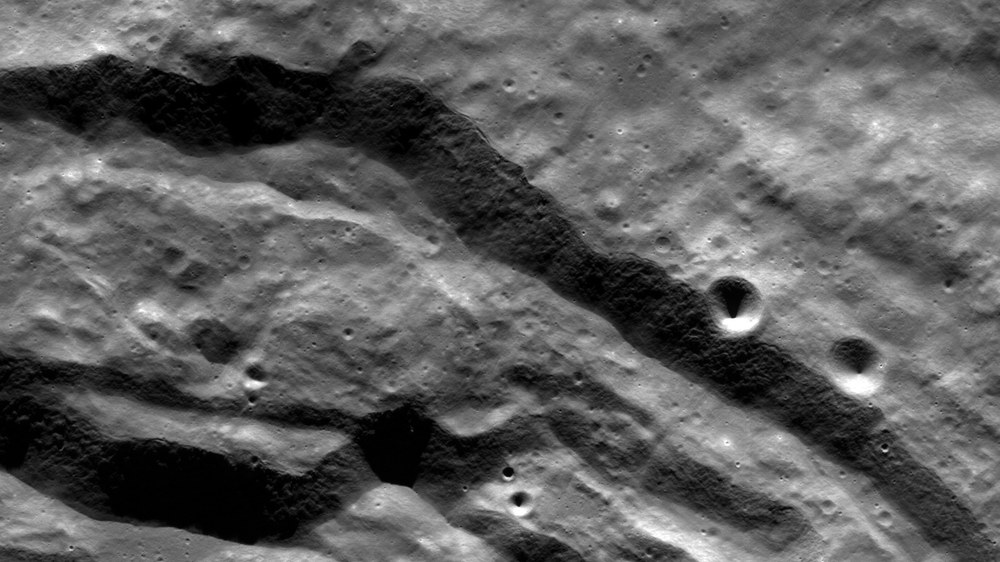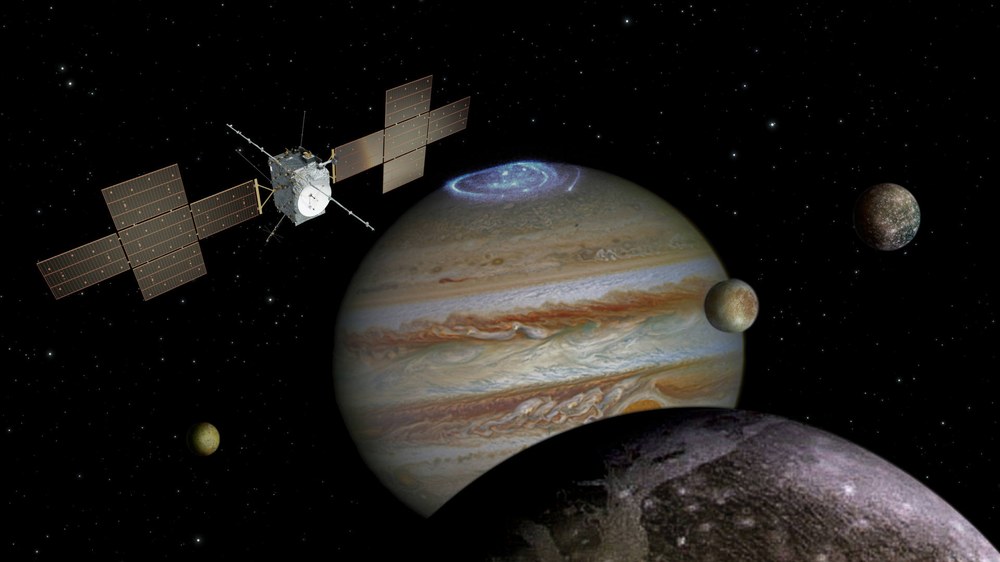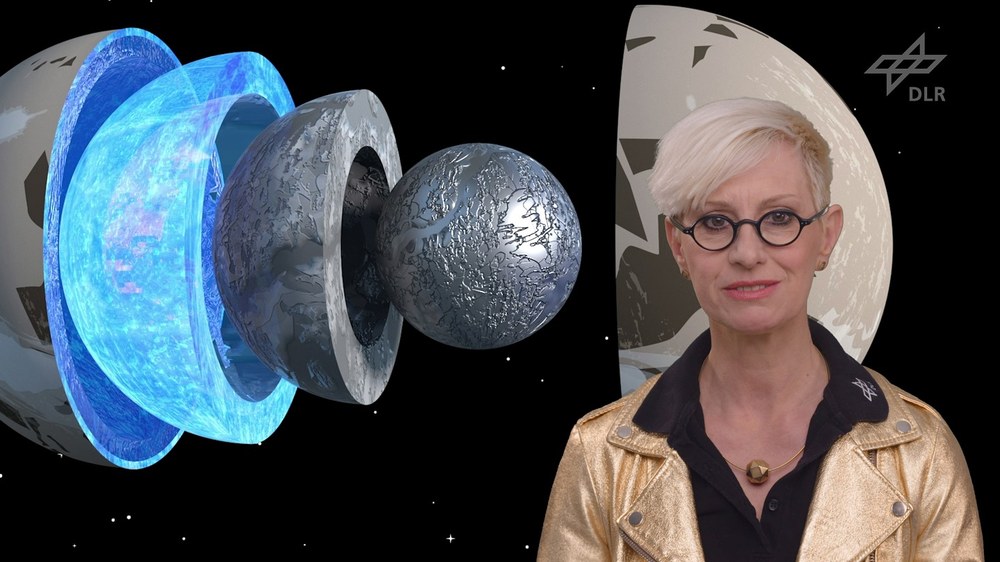DLRmagazine article: Of distant moons and oceans (Issue 169)
Two DLR instruments will investigate Jupiter's icy satellites.



ESA/ATG medialab (Sonde); NASA/JPL/DLR (Jupiter, Monde)
+++ UPDATE: ESA’s JUICE mission performed two close flybys, first of the Moon on 19 August 2024 and the following day of Earth, which went exactly as planned. This was the first time in the history of spaceflight that such a manoeuvre was carried out. Thanks to incredibly precise navigation, only a fraction of the fuel reserved for this flyby was used.
During the 'LEGA' (Lunar Earth Gravity Assist) manoeuvre, JUICE was guided to fly past the lunar surface at a distance of 650 kilometres at 23:15 CEST, and so was accelerated onto the right course for Earth. JUICE flew towards Earth at a speed of 6.4 kilometres per second, with the space probe passing within 6840 kilometres of our planet at 23:56 CEST on 20 August 2024, being slowed down and steered towards Venus exactly as planned. The lunar flyby increased the spacecraft's speed by 0.9 kilometres per second relative to the Sun and steered it towards Earth. The Earth flyby reduced its speed by 4.8 kilometres per second relative to the Sun and steered it onto a new trajectory towards Venus. In total, the lunar-Earth flyby deflected JUICE by an angle of 100 degrees compared to its trajectory before the manoeuvre. +++
The highly anticipated space manoeuvre has been named LEGA, for 'Lunar-Earth Gravity Assist' – which roughly means Moon-Earth gravity deflection. For the first time, the orbit of a space probe will be altered by the Moon's gravity and, shortly afterwards, by Earth's. During the night of 19 to 20 August (CEST), the European Space Agency's (ESA) JUICE mission will first pass by Earth's Moon from the night side at an altitude of 750 kilometres. The space probe will then fly to Earth in just 24 hours at an increased speed of 15,000 kilometres per hour on an already slightly altered trajectory, coming as close as 6800 kilometres to our planet. The probe’s orbit will then be altered a second time and deflected in the direction of the inner Solar System.
During the close approaches of the Moon and Earth, scientific experiments will be switched on in order to be tested and calibrated, potentially even obtaining interesting results. These include the JANUS camera and the GALA laser altimeter, both of which the German Aerospace Center (Deutsches Zentrum für Luft- und Raumfahrt; DLR) is significantly involved in.
The unusual manoeuvre is being executed to save fuel for the remainder of the mission. In the coming years, JUICE will be accelerated by three more flybys – one of Venus and two of Earth – enabling it to reach its final destination in 2031: Jupiter and its icy moons Europa, Ganymede and Callisto, which it will study until 2035.
With a bit of luck, JUICE could even be visible from Earth during the LEGA manoeuvre, as the spacecraft flies through the night in the western hemisphere and then during the day above Southeast Asia and the Pacific Ocean. On the night of 20 to 21 August, amateur astronomers in Europe will have the chance to see the spacecraft as a fast-moving point of light using powerful binoculars or a telescope. (For more information, see link at the bottom of the page).

Video: Journey to Jupiter: Germany's participation in JUICE
Your consent to the storage of data ('cookies') is required for the playback of this video on Youtube.com. You can view and change your current data storage settings at any time under privacy.
This complex trajectory through the inner Solar System proved to be the most effective way of steering the space probe, which weighed over six tonnes at launch, into the Jupiter system as quickly as possible. The diversion via Venus is a time-saving shortcut. JUICE was launched on 14 April 2023 from Europe's Spaceport in Kourou, French Guiana, on an Ariane 5 launcher. Since then, the spacecraft has already travelled more than one billion kilometres.
The LEGA manoeuvre is being managed and controlled by ESOC, ESA's European Space Operations Centre in Darmstadt, Germany. Their aim is to steer JUICE towards the Moon and then towards Earth at exactly the right speed, at the exact time and in the exact direction. The manoeuvre is like shooting through the eye of a needle, and no space agency has ever carried out this double manoeuvre before. JUICE's path will be monitored every second between 17 and 22 August 2024. Radio communication with the space probe will take place via the three large Estrack antennas at ground stations in Spain, Australia and Argentina. According to ESA, the manoeuvre is not without risks. At 38 minutes before its closest approach of the Moon, at 23:16 CEST on Tuesday 20 August, JUICE will be eclipsed by our lunar satellite. For about half an hour during this period in the Moon’s shadow, no contact will be possible between JUICE and Earth.
The scientific benefit of this close double flyby will be measurements taken by the ten instruments onboard JUICE, which were developed for use during flybys of Jupiter's three large icy moons. The instruments will all be switched on and record data above the surface of the Moon, and most will be switched on again 24 hours later during the Earth flyby. The physical measurements and recordings from the imaging experiments will first and foremost serve to check the instruments are working following JUICE’s launch and after 16 months exposed to space, as well as to calibrate the sensors.
During the lunar flyby, JUICE will come within 750 kilometres of the Moon's surface. The JANUS camera will not be pointed vertically at the lunar surface but will achieve an optimum resolution of approximately 13 metres per pixel. The final image on departure from the Moon will be captured at a distance of 2800 kilometres and will have a resolution of 42 metres per pixel. The photographed regions lie on a narrow strip along the lunar equator, both on the far side and the near side which will be fully illuminated due to a full Moon. The images of Earth will have resolutions between 125 metres – albeit over the ocean – and 250 metres per pixel due to the greater overflight altitude. Parts of Madagascar, Thailand, Cambodia, the Philippines and Hawaii will be photographed.
DLR is involved in the instrumentation of the JUICE mission with a combined 'one-and-a-half' hardware contributions. The DLR Institute of Planetary Research contributed several hardware components to the JANUS camera system (Jovis, Amorum ac Natorum Undique Scrutator; Latin for 'Comprehensive exploration of Jupiter, and his loves and descendants'), which was developed and built in Italy by Leonardo S.p.A.. The scientific team is led by Pasquale Palumbo at the Istituto Nazionale di Astrofisica (INAF) in Rome and Ganna Portyankina from the DLR Institute of Planetary Research. Image planning, camera operation, data processing and scientific analysis will be shared between the two institutions to optimise the results.
Germany is also represented in the mission by the Ganymede Laser Altimeter (GALA), which was jointly developed with German industry and contributions from Japan, Spain and Switzerland under the leadership of Principal Investigator (PI) Hauke Hußmann at the DLR Institute of Planetary Research. GALA emits 30 laser pulses per second onto solid surfaces and measures the time it takes for the reflected laser pulse to arrive back at the instrument's telescope. This enables height and depth to be recorded using millions of measurement points, giving a comprehensive picture of, for example, the topography and shape of a planetary body. GALA will initially record height profiles on the moons Callisto and Europa in the Jupiter system, but its principal task will be centred around Ganymede, recording a topographical map of its entire surface as well as measuring the deformation of its crust – the effect of tidal forces as the moon orbits Jupiter. These Ganymede orbits will occur in the later stages of the mission, in order to verify – or not – the existence of an ocean under the moon's icy crust.
GALA will take measurements during the first part of the lunar-Earth manoeuvre and will be switched on during the flyby of the Moon. JUICE's 850-to-1200-kilometre distance from the Moon’s surface will allow measurements to be taken and distances determined, used to test and calibrate the instrument. When JUICE flies by Earth however, the distances will be too great for useful measurements. The GALA command sequence for the lunar flyby has already been sent to ESA in the beginning of August. Within a few minutes of the closest approach to the Moon, GALA will take distance measurements at a rate of 30 pulses per second to obtain a ground track of the lunar surface at a minimum altitude of approximately 850 kilometres.
This 'dress rehearsal' for future Ganymede measurements will be used to calibrate the instrument's various settings and to check its performance and signal-to-noise ratio. The lunar flyby is the only opportunity for such measurements before it enters Jupiter's orbit in 2031. The GALA team has already simulated the measurement campaign at the Moon and assumes that the signal will weaken with increasing distance, but also that a ground profile of the lunar surface, with topographical measurements, can still be recorded.
Calibration of the exact geometric alignment of GALA is also planned in conjunction with the JANUS team. JANUS will attempt to record, in long exposures, the laser pulses 'shot' at the Moon by GALA during the flight over the lunar hemisphere not illuminated by the Sun. As both instruments, GALA and JANUS, look in exactly the same direction on their 'optical bench', slight deviations in the recordings of the GALA laser pulses on a specific pixel of the JANUS image sensor would improve the geometric calibration for use on Ganymede. However, due to the expected scattered light at the day-night boundary of the Moon, there is no guarantee that this experiment will deliver the hoped-for data.
Germany is significantly involved in the JUICE mission. The German Space Agency at DLR is supporting JUICE by making the largest single contribution of an ESA member state to the mission – around 21 percent. These funds are part of the financing for the development of the space probe, its launch on an Ariane 5 rocket and mission operations. In addition, approximately 100 million euros are being channelled into German contributions to seven of the ten scientific instruments and one experiment on the spacecraft:
In addition, the PRIDE experiment (Planetary Radio Interferometer & Doppler Experiment), although not an instrument in itself, uses the radio link between the main antenna and Earth for measurements. There are also other scientific collaborations such as MAJIS (the Moons and Jupiter Imaging Spectrometer), an instrument also developed by MPS.
The change in orbit and speed of a spacecraft caused by a close planetary or, in this case, lunar flyby, is based on the fact that spacecraft have a significantly lower mass than these huge celestial bodies, resulting in a 'gravitational deflection'.
When a probe approaches a large celestial body and moves through its gravitational field, it is deflected by gravitational pull. If it moves too quickly through the gravitational field, virtually nothing happens, but if it moves too slowly, it is pulled so strongly towards the celestial body that it crashes into it. As is always the case with space flight, maximum precision is therefore required when calculating the speed and altitude of the flyby.
As a spacecraft approaches a flyby, it speeds up in relation to the larger object, only to be slowed down again by its gravity as it leaves. From the point of view of the celestial body, the spacecraft leaves with the same energy as it arrived, but while the probes 'orbital energy' remains constant in relation to the celestial body, the direction of the 'velocity vector' has changed.
Because the spacecraft and the celestial body move together around the Sun (in a heliocentric orbit), the 'vector sum' of the velocity of the planet and the spacecraft around the Sun changes. The spacecraft therefore travels faster in relation to the Sun when it passes behind the celestial body or, as with JUICE's LEGA manoeuvre, travels slower when it passes in front of the celestial body. The large celestial bodies (like the Moon and Earth) and the smaller object (JUICE) therefore exchange kinetic energy with each other. Of course, the kinetic energy of the large celestial body also changes in the process – albeit by a tiny, immeasurable amount. Occasionally, these manoeuvres are also combined with additional thrust from the spacecraft's engines.
